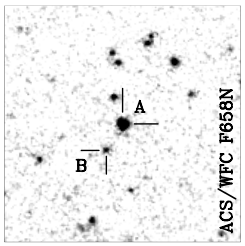The progenitor of the May supernova in M51 identified

The progenitor star that produced the May supernovae in the Whirlpool Galaxy (also known as M51) has been identified, and it isn’t what scientists predicted.
In a preprint paper published today on the Los Alamos astro-ph website, astronomers describe the star that exploded as a yellow supergiant, not a red supergiant or Wolf-Rayet star, as predicted by the theory explaining this particular type of supernova. Moreover, though theory also favors the star being a member of a binary system, the progenitor of 2011dh appears to be a lone star, not even a member of a cluster.
Before it exploded, the star is believed to have been an F-type supergiant with an effective surface temperature of approximately 6000 degrees Kelvin and a core mass of about 13 solar masses. The spectroscopy suggests that the star had already lost most of its hydrogen envelope prior to the eruption, and was burning its helium core.
This new data point only adds to the growing database of supernovae progenitors that is increasingly baffling the theorists, as the mix of properties and types of these stars is not matching their theories. As noted in the paper’s conclusion:
Despite the canonical prediction that Type II supernovae arise from red supergiants, there is mounting evidence that some stars explode as yellow supergiants. A handful of Type II supernovae have been observed to arise from yellow supergiants: SNe 1993J and 2009kr. The locations of the progenitors on the Hertzsprung-Russell diagram shows clearly that these stars are not located on the predicted end points for single star stellar evolution tracks. In addition, despite arising from supposedly similar yellow supergiant progenitors, these supernovae display a wide range of properties.
Not surprising, nature is once again throwing us a curveball. The kinds of supernovae and the stars that produce them is turning out to be far more complicated than the theorists had predicted. And without a solution to this mystery, it will be impossible for scientists to identify which stars in our galaxy will be the next to go boom.
On Christmas Eve 1968 three Americans became the first humans to visit another world. What they did to celebrate was unexpected and profound, and will be remembered throughout all human history. Genesis: the Story of Apollo 8, Robert Zimmerman's classic history of humanity's first journey to another world, tells that story, and it is now available as both an ebook and an audiobook, both with a foreword by Valerie Anders and a new introduction by Robert Zimmerman.
The print edition can be purchased at Amazon or from any other book seller. If you want an autographed copy the price is $60 for the hardback and $45 for the paperback, plus $8 shipping for each. Go here for purchasing details. The ebook is available everywhere for $5.99 (before discount) at amazon, or direct from my ebook publisher, ebookit. If you buy it from ebookit you don't support the big tech companies and the author gets a bigger cut much sooner.
The audiobook is also available at all these vendors, and is also free with a 30-day trial membership to Audible.
"Not simply about one mission, [Genesis] is also the history of America's quest for the moon... Zimmerman has done a masterful job of tying disparate events together into a solid account of one of America's greatest human triumphs."--San Antonio Express-News


Very cool! It is a shame that shows on TV (Discovery, History, Science) present the current theory of such events as absolute fact. When, the truth is these theories are in constant flux as new data is uncovered!